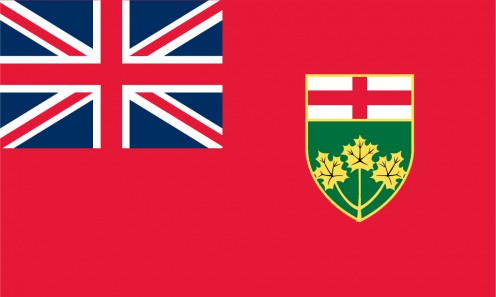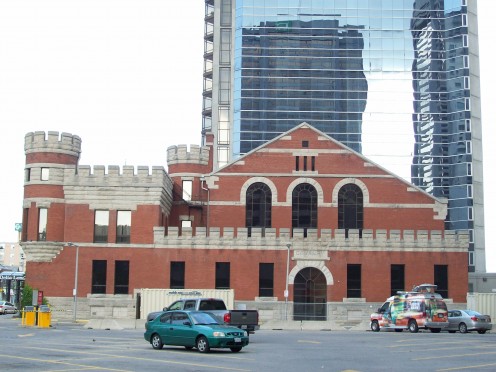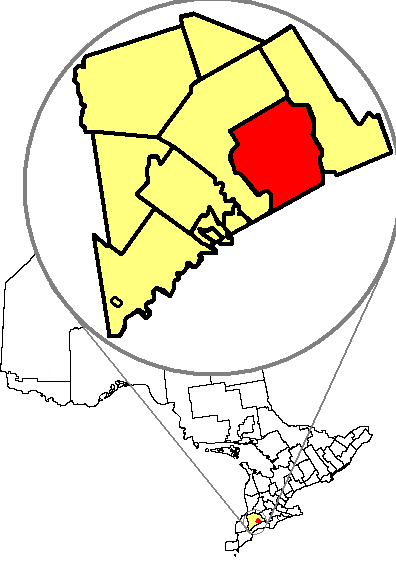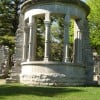Visiting the Armouries, London, Ontario: Monumentality Adapted



Changing symbolism
This unavoidable edifice at 325 Dundas Street has sometimes been known locally as 'Old Armours'. The castle-like building, in Downtown London, Ontario, looks as if it was once a military fortress.
Well, in a sense, this is pretty much what it was. Known still as the Armouries, and dating from the year 1905, this monumental edifice has been a local landmark for more than a century, causing passers-by to remember an era when this area of Western Ontario was a significant military centre (1). The Armouries formerly housed the First Hussars.
1905 was only 38 years since Confederation, less than four decades since US President Andrew Johnson was privately encouraging Fenian raiders in their efforts to attack the US-Canadian border. Defence of that border was still an active issue, and, for Canadians, identifying with British military might was a corollary of this issue.
The round, corner tower of the former Armouries has now become somewhat of a signature feature of the hotel. With a military use for the building having become redundant, the Armouries were eventually and tastefully adapted into what has become one of London's leading hotels: the Delta London Armouries Hotel. Completed 1987, the hotel is 23 storeys high and rises to 70 metres.
From a symbolic point of view, this monumental building may be said to have represented something of the military might of the British Empire at its height in the years prior to the cataclysmic convulsion which World War One constituted. Ontarians, for their part, tended to support British war aims in Europe, while not necessarily asking very deeply what these might imply for Canada and the relationship between Canada and Great Britain. Then came the slaughter at the Somme and Flanders; with Canadian military achievement and sacrifice of distinction at Vimy Ridge, and elsewhere. By this time British generals were sending thousands of Canadians to their deaths to capture gruesome killing fields such as Passchendaele — only to withdraw them without a fight from such narrow portions of mud. Canadians, for their part, were questioning increasingly what the relationship between Canadians' parliamentary representatives and the British Imperial Command ought really to be. By 1922, when the British government tried to get Canada to go to war at Chanak, unquestioning identification with British Imperial war aims, whatever they might be, had ceased to motivate Canadians generally in the same way as it had done even a few years previously: Arthur Meighen's 'Ready, aye, ready!' message fell on deaf ears; the more subtly pacific William Lyon Mackenzie King was more in tune with the national mood when he politely declined to join British Prime Minister David Lloyd-George in its proposed, fresh war.
Having thus symbolized, more than a century ago, British military might, today 'Old Armours', as part of the well appointed Delta London Armouries Hotel, has now become, to its many Canadian, American and other guests, a welcoming symbol of Canadian hospitality to visitors from across the most peaceful border in the world.
What a great turnaround, then, from the days of this building's inception! and what a lot of latent history it encompasses!
Note
(1) The Royal Canadian Regiment Museum, in Elizabeth Street, London, may be visited.
Also worth seeing
In London itself, other buildings of note include St Paul's Cathedral, Eldon House and the Middlesex County Court building.
...
How to get there: Air Canada flies to London International Airport, from Toronto Pearson Airport, from where there are wide North American and other connections. Car rental is available at London International Airport. VIA Rail serves London , connecting with Windsor and Toronto, and other cities. Some facilities may be withdrawn without notice. Please check with the airline or your travel agent for up to date information. Contact is advised with appropriate consular sources for any special border crossing arrangements which may apply to citizens of certain nationalities.
MJFenn is an independent travel writer based in Ontario, Canada








